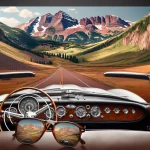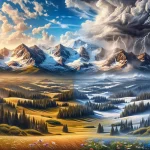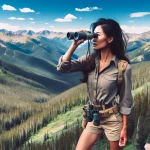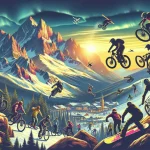Colorado has emerged as one of the premier destinations in the United States for viewing the magical light show of the Northern Lights. The state’s high elevation, clear skies, and optimal latitude create ideal conditions for witnessing these dazzling displays of color in the night sky. This article explores everything you need to know to successfully see the aurora borealis in Colorado, from the science behind the phenomena to the best places and times to view them. We’ll also provide tips on photography, tours, and educational resources. Whether you’re a first-time aurora watcher or a seasoned veteran, Colorado offers a fantastic aurora viewing experience.
In This Article
TL;DR
- Colorado's high elevation and clear, dark skies make it an exceptional place for seeing the auroras.
- Late fall through early spring are the peak viewing seasons, with March and April ideal for vibrant displays.
- Estes Park, Rocky Mountain National Park, and the Pawnee National Grassland are prime spots with accessible viewing areas.
Overview of Aurora Watching in Colorado
Colorado’s unique combination of geographic and atmospheric conditions primes the state for witnessing the magical glow of the auroras. Situated at 40°N latitude, Colorado lies directly under the auroral oval, the ring-shaped region around the North Pole where the most dazzling auroral displays occur. The state’s high elevation and thin atmosphere also play key roles. At altitudes above 5000 feet, observers are closer to the Northern Lights, and less atmosphere means clearer viewing. Finally, Colorado’s many cloudless nights, especially in winter, create ample opportunities for sightings.
These factors make Colorado a mecca for aurora enthusiasts. While sightings occur year-round during solar storms, the peak auroral season runs from September through April. This coincides with longer nights and increased geomagnetic activity as Earth’s orientation exposes it to heightened solar winds. From the Pawnee National Grassland to Rocky Mountain National Park, many ideal viewing locations exist across Colorado’s high plains and alpine areas. Read on to discover the best places and times to see the auroras dance across Colorado’s skies.
Historical Background
For millennia, indigenous peoples in Colorado witnessed and developed myths around the dazzling auroral displays. The Pawnee people interpreted the lights as celestial campfires, while other tribes saw them as supernatural battles or communications from the spirit world. These communities appreciated the auroras’ beauty and incorporated them into cultural traditions.
In modern times, scientists have intensively studied auroras to unravel the complex physics behind them. Pioneering observations in the 19th century revealed connections between solar flares and subsequent auroral storms. Researchers now understand auroras form when charged particles from the solar wind interact with Earth’s magnetic field and atmosphere. This produces a visible light show as atmospheric gases glow across the electromagnetic spectrum. Ongoing research, including at Colorado’s own National Oceanic and Atmospheric Administration laboratory, continues unraveling auroral mysteries.
Prime Aurora Viewing Locations in Colorado
Rocky Mountain National Park
Encompassing 415 square miles of rugged peaks and pristine wilderness, Rocky Mountain National Park offers phenomenal aurora watching. Many park overlooks and lakes provide sweeping vistas to monitor for auroral displays. Popular spots include Upper Beaver Meadows and Rainbow Curve for roadside viewing and Dream and Emerald Lakes for backcountry viewing. Ensure proper winter preparations for cold temperatures and deep snow during peak season, and check the weather forecasts provided by the National Weather Service to anticipate ideal aurora weather. Precipitation, such as snow, rain, and cloud cover, can affect visibility.
Estes Park
Serving as the gateway town to Rocky Mountain National Park, Estes Park is another auroral hotspot. Drive up nearby High Drive for panoramic views across town, or head to Lake Estes for reflections of the lights dancing over the Rockies. The historic Stanley Hotel also offers nightly auroral-watching sessions on their lawn, complete with telescopes and astronomy experts on hand.
Pawnee National Grassland
The Pawnee Buttes in northeastern Colorado offer exceptional high-plains viewing opportunities. With dark skies and wide horizons unobstructed by mountain peaks, observers can watch auroral displays and meteor showers for hours. Pawnee Campground provides an accessible basecamp to witness these celestial events unfold across the prairie.
Best Times of Year To See Auroras in Colorado
Colorado’s auroral viewing season runs from late August through early April, with peak activity occurring between November and March. Long, cold nights and active geomagnetic storms create prime sighting opportunities throughout the winter. However, Colorado’s high elevation also enables auroras during summer when solar activity increases.
The vernal (March) and autumnal (October) equinoxes also present ideal viewing windows. During the equinox periods, Earth’s tilted axis neither points toward nor away from the Sun, exposing it to heightened solar wind activity. Dazzling all-night light shows can materialize if an auroral storm coincides with an equinox’s equal day/night duration.
Use online tools like the Aurora Forecast or real-time auroral oval maps to monitor solar storm activity and subsequent viewing conditions. While auroras appear sporadically, these resources help pinpoint potential sighting nights across Colorado.
Top Tips for Photographing Auroras
Capturing the fleeting glow of auroras presents challenges for photographers. But with proper planning and the right equipment, you can create spellbinding images. Use these tips to master the intricacies of aurora photography:
Gear Up
– Use a DSLR or mirrorless camera with full manual controls and interchangeable lenses. A sturdy tripod, remote shutter trigger, and wide, fast lenses (f/2.8 or lower) also prove essential.
Determine Exposure
– Given the low light levels, high ISO settings around 1600-3200 balanced with 5-30 seconds exposure typically work best. Utilize the 500 Rule to estimate the proper shutter speed.
Focus and Compose
– Manually focus your lens on infinity (∞) before shooting. Frame compositions using foreground objects like mountains or trees to add scale and interest to images.
Review and Adjust
– Check images between shots and adjust settings as needed to properly expose the auroras’ colors and activity. Slight tweaks to ISO, aperture, and shutter speed go a long way.
Ongoing Aurora Research
While indigenous peoples have observed auroras for ages, the scientific study of these mysterious lights is still in its infancy. Ongoing research continues to unveil new insights into the drivers and intricacies of auroral physics.
Recent advances include high-resolution imaging, which identifies new types of auroral forms. Satellite monitoring and advanced modeling also now enable accurate short-term forecasting of auroral events. Machine learning techniques even allow automated image analysis to classify auroral shapes and brightness in real-time.
At the forefront of this research is Colorado’s own Space Weather Prediction Center (SWPC), run by the National Oceanic and Atmospheric Administration (NOAA) in Boulder. SWPC monitors solar activity and geomagnetic conditions 24/7 using a suite of ground and space-based instruments. This data feeds forecast models that issue alerts for impending auroral events across Colorado and North America.
Local Aurora Myths and Legends
For indigenous peoples across Colorado, the mysterious lights held deep cultural significance tied to spiritual beliefs and oral traditions. Various tribes interpreted the Northern Lights as supernatural battles between sky spirits, celestial campfires, hunting grounds, bridges between worlds, and communication from gods or ancestors.
The Pawnee people viewed the auroras as celestial smoke signals indicating war was afoot within the tribe. Northern Arapaho traditions saw the lights as a battle between Nanabozho, the trickster rabbit spirit, and giant grizzly bears in the sky realms. In Navajo culture, the auroras signified Coyote, the troublemaker god, lighting cosmic campfires in the north.
These varied and vibrant mythologies enriched tribal ceremonies, storytelling, and artwork for generations. Remnants of these beliefs and symbols still appear in modern indigenous art and cultural practices across Colorado. When witnessing the auroras, one can’t help but imagine these colorful tales coming to life overhead.
Resources for Learning About Auroras in Colorado
A wealth of educational opportunities exist across Colorado for learning about the science and beauty of auroras:
Aurora Nights at Stanley Hotel
– Nightly stargazing events featuring presentations on space weather, aurora science, and viewing tips from astronomers.
Fiske Planetarium
– Engaging shows and lectures on the latest aurora research at the University of Colorado Boulder.
SWPC Aurora School
– Online modules, data tools, and multimedia resources from NOAA’s Space Weather Prediction Center.
Girl Scouts Space Science Badges
– Fun auroras-focused programming and patches from the Girl Scouts of Colorado are engaging next-gen scientists.
Citizen Science Projects
– Contribute observations as an aurora spotter for research groups like Aurorasaurus and the Auroral Activity Network.
Whether interested in science, photography, or simply beholding nature’s beauty, these resources enhance Colorado’s exceptional auroral experiences.
FAQ
How do I know when auroras will happen?
To predict events, check real-time auroral oval maps, activity indexes, or 3-day forecasts. Peak seasons run from September to April, especially around the equinoxes.
What time of night is best to see auroras?
Most auroral activity occurs between 10 pm and 2 am local time. Adjust for daylight savings time between March and November.
Where can I find accessible viewing spots near Denver?
Lookout Mountain in Golden, Meyer Ranch Park, and Deer Creek Canyon offer proximate night sky viewing less than an hour from Denver.
Is winter or summer better for seeing auroras in Colorado?
Increased solar activity in summer enables rare sightings despite shorter nights. But winter’s long nights, clear skies, and heightened geomagnetic storms make it the prime viewing season.
How can I photograph auroras without expensive cameras?
While DSLRs help, modern cellphone cameras can capture decent images using Night Mode and tripods. Just don’t expect National Geographic quality!






